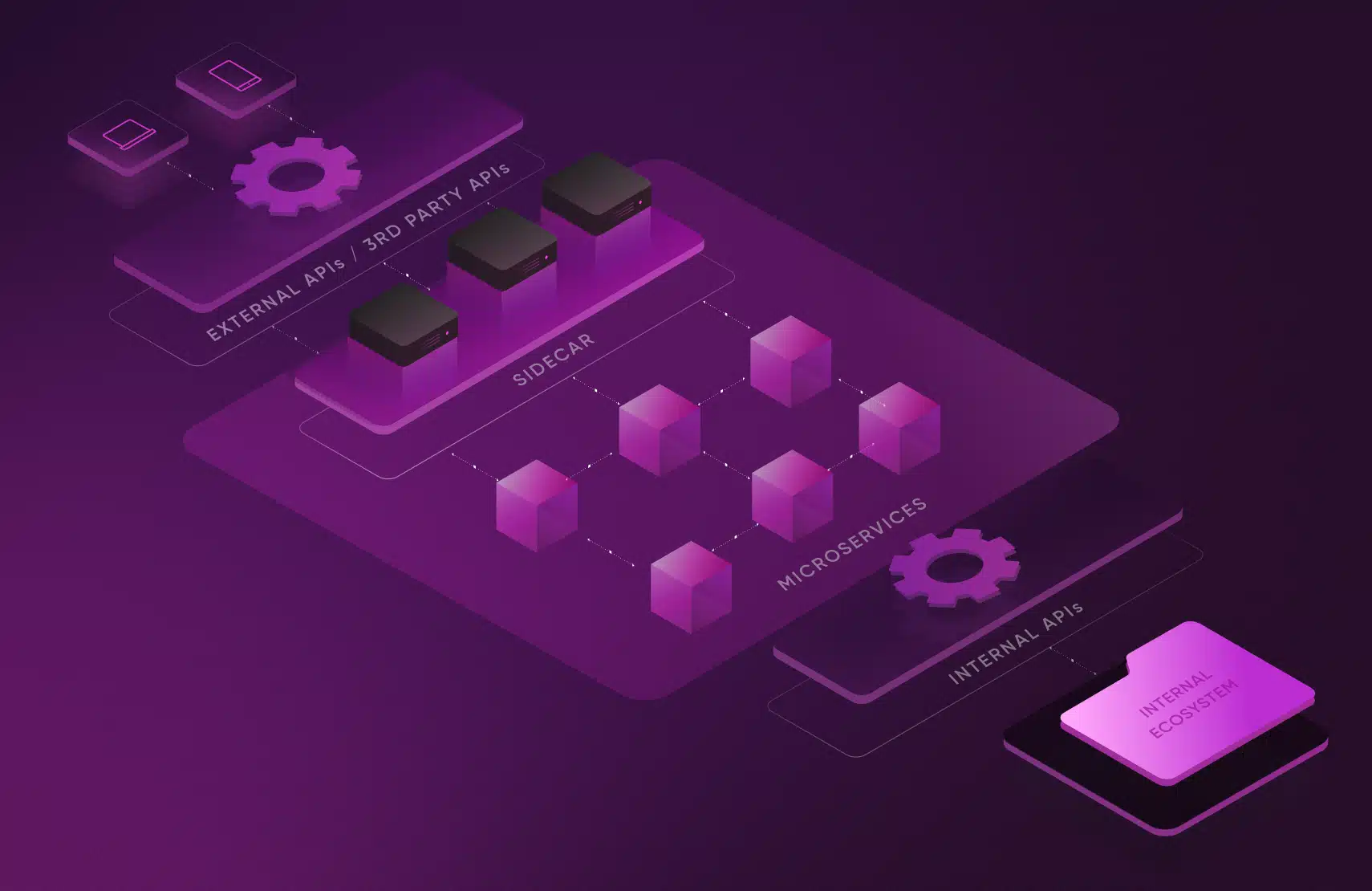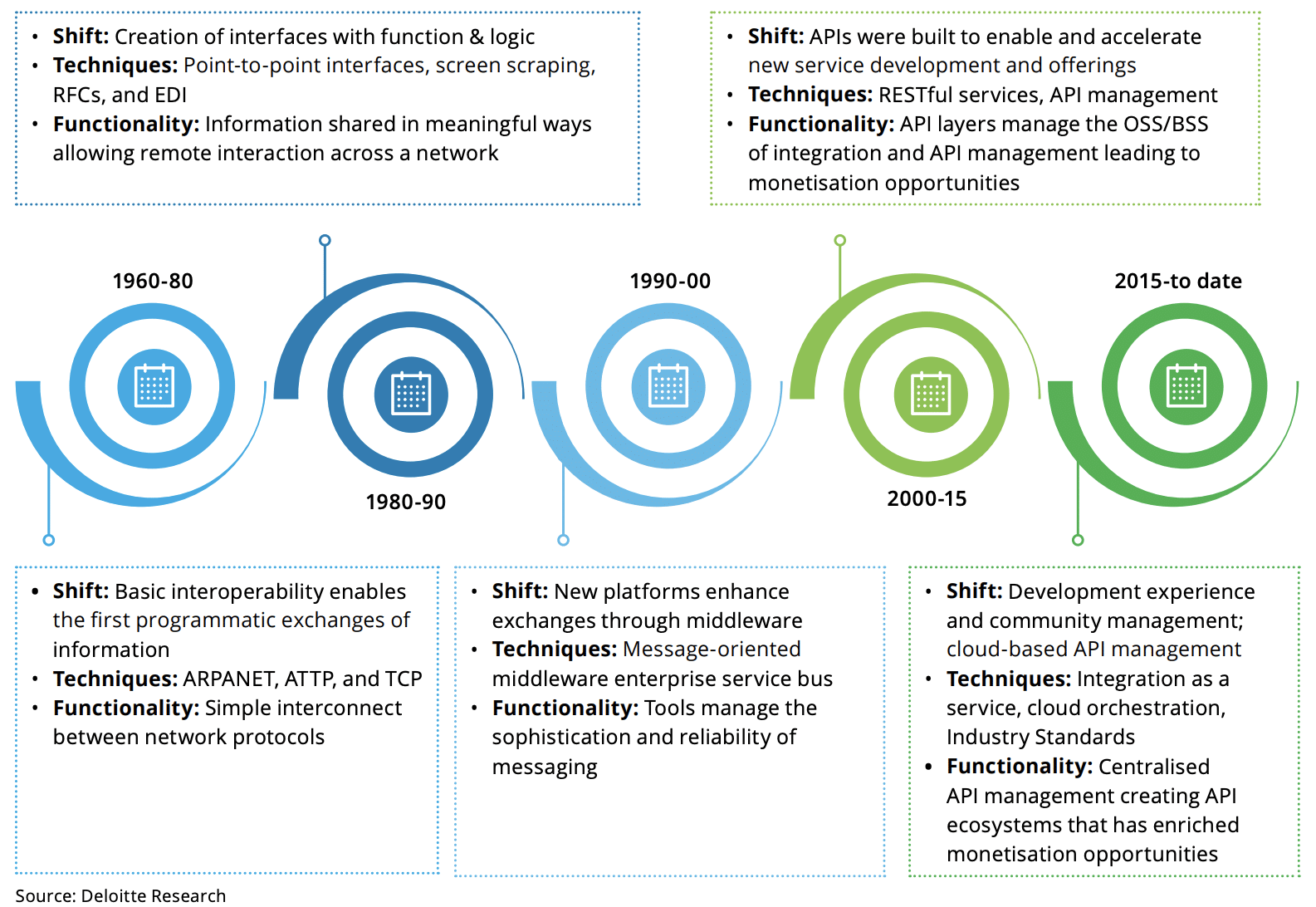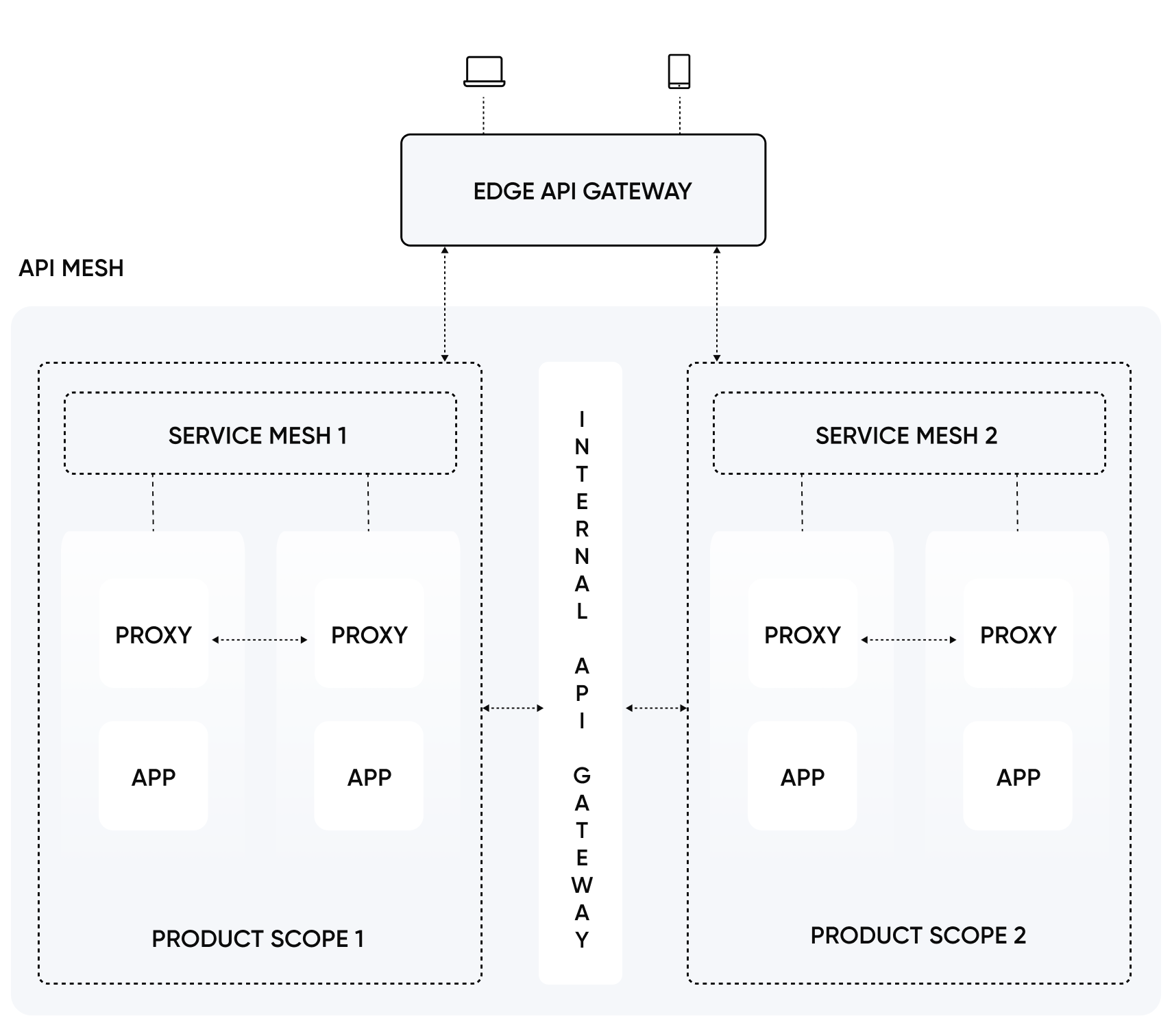Developing an API Mesh for E-Commerce Services and Modules

An API mesh is a network of interconnected APIs that collaborate and communicate with each other.
Managing and orchestrating internal and external API calls allows for seamless and flexible integrations of various applications and services.
An API mesh in e-commerce provides enhanced interoperability, scalability, flexibility, improved security, easier tracking, and compliance with rules and regulations.
fabric Commerce Platform is a comprehensive commerce solution that effortlessly integrates with and orchestrates a diverse array of APIs, empowering businesses to streamline their operations efficiently.
With the pace of innovation in today’s digital landscape, many businesses have realized that application programming interfaces (APIs) are an effective way to enable the digital transformation of their enterprises. According to Deloitte, this has given rise to the API economy, which enables the creation of new and unique applications from a combination of APIs fueling novel and innovative business models. A brief history is outlined below:

This is where an API mesh can come into play. By developing an API mesh, businesses can simplify the integration and management of diverse systems to create a unified and interconnected ecosystem that’s built for commerce.
[toc-embed headline=”What is an API Mesh?”]
What is an API Mesh?
An API mesh refers to a network of interconnected APIs that collaborate and communicate with each other to provide a seamless and flexible integration of various services and functionalities.
It allows for the smooth flow of data and interactions between different APIs, enabling businesses to efficiently orchestrate and manage their diverse systems and applications. It can group services together into common calls, creating your own API that can be extended as you add features. Though setting up an API mesh takes work, you can reap the benefits of having a single point of access to your APIs, particularly if you use a complex web of APIs that are hard to manage without help.
The API mesh features things like load balancing and encryption, which make your interaction with services safer and more reliable. It promotes interoperability, scalability, and agility by facilitating the exchange of data and functionality across multiple services, both internally within a company’s tech stack and externally with third-party systems.
Although an API mesh is similar to a service mesh, they differ in that a service mesh specifically focuses on managing the communication and interactions between microservices within a distributed system, while an API mesh typically refers to the integration and collaboration of APIs across multiple systems.
[toc-embed headline=”How Does an API Mesh Work?”]
How Does an API Mesh Work?
An API gateway acts as a central entry point for accessing and managing APIs, while an API mesh extends the capabilities of an API gateway by interconnecting multiple APIs and enabling seamless communication and collaboration between them. The process of coordinating and managing the interactions between multiple APIs is referred to as API orchestration.

With an API mesh consolidating your APIs, you are free to build whatever you need on top of them. The API mesh can present incoming APIs to your other services in the format of your choice, and you can build an interface that takes advantage of whatever technologies or languages most suit your use cases.
This gives you complete extensibility, allowing you to build features as you need them. For instance, if you want to build a REST API, you can add features that draw on all your existing services.
[toc-embed headline=”Why an API Mesh is Important”]
Why an API Mesh is Important
Because an API mesh handles all the internal and external APIs your system needs to deal with, this allows you to build faster and better without having to chase your tail as other services change.
In e-commerce, that’s especially beneficial. The APIs used in e-commerce transactions are numerous and complex, so simplifying things is of enormous benefit to those building services on top of them. Furthermore, you’re able to combine services and handle them from a central location, which offers enhanced service discovery and makes them easier to modify. Let’s talk about some of these advantages in more detail:
Centralization
Combining services with an API mesh allows you to handle all of them from a central location. This allows for easier management and control of API interactions and simplifies development and maintenance processes. You can create management interfaces that handle each subsection of your e-commerce setup, giving you central governance of the entire system. This allows you to track what’s going on in one place.
You get a complete overview of the system and can make changes that affect services together, using the consistency and reach that a common interface gives you. You can manage sales, products, and payments in one place, making it easier for your developers and other teams.
Enhanced service discovery
Moreover, with an API mesh, your service discovery is enhanced. It’s easy to browse through what’s available and an API mesh makes it much less likely for developers working with your services to overlook things.
Those that focus on interfacing with the various incoming APIs can ensure their features are all available to frontend developers, meaning they can take advantage of them. For example, if you have a pricing and promotions API, developers wanting to use it with sales or product data will be able to easily find it.
Flexibility in modifying and evolving APIs
With an API mesh, modifications and updates to individual APIs can be made independently without affecting the entire system. This promotes agility and scalability as businesses can adapt their APIs to changing requirements more efficiently.
For example, multiple apps dealing separately with multiple services means there are more opportunities to get things wrong. This can be catastrophic with e-commerce when you have multiple sensitive systems handling payments and customer data that frequently need to interact. An API mesh allows businesses to make changes to specific APIs without disrupting other components, enabling them to address issues quickly, iterate, introduce new features, and respond effectively to changes in the market.
Security
An API mesh also provides an extra layer of protection from the outside world. It insulates you from attacks as it keeps a clear line between external services and your own. Having created your own abstraction layer to interact with your own services, you can add whatever style of encryption meets your needs, adding further security.
You can implement security measures such as authentication, authorization, and encryption. This helps ensure consistent and robust security practices across all APIs within the mesh.
Observability
An API mesh provides enhanced observability, allowing businesses to gain deep insights into the behavior and performance of their APIs. Through monitoring and logging capabilities, businesses can track metrics, detect anomalies, and troubleshoot issues promptly, ensuring optimal API performance and reliability.
Traffic management
With an API mesh, businesses can effectively manage the flow of traffic between APIs. It enables features such as load balancing, routing, and traffic shaping, which distribute incoming requests across multiple instances, optimize resource utilization, and prevent single points of failure. This traffic management capability ensures high availability, scalability, and efficient resource allocation within the API ecosystem.
Stability and resiliency
An API mesh enhances stability and resiliency by implementing mechanisms like circuit breakers, retries, and timeouts. These features help handle failures gracefully, isolate and contain issues to prevent cascading failures, and improve the overall reliability of the system. The API mesh architecture enables fault tolerance and ensures that failures in one API or service do not bring down the entire system.
Who can benefit from it
Building an API mesh is an investment. Setting it up is complex, but once running, it reduces the complexity of adding new services.
API meshes offer a greater advantage to larger organizations. As the number of incoming services you use increases, so do the benefits of managing them efficiently. Complex systems become exponentially more difficult to manage as they grow, so anything you can do to mitigate that is a real help to anyone interacting with them.
If you have a lot of microservices, it’s also better to do that in one place. It’s cleaner and easier to manage. Your developers can add features easily, knowing that API-specific issues are being handled by the API mesh.
[toc-embed headline=”5 Best Practices for Building a Highly Effective API Mesh”]
5 Best Practices for Building a Highly Effective API Mesh
By following best practices, businesses can create a well-structured and efficient API mesh that promotes seamless communication, enhances performance, improves security, and ensures the stability and reliability of the entire API ecosystem. Here are 5 to consider:
1. Auto inject proxies
A service mesh uses a sidecar proxy to feed data into the rest of the system. Keeping this on the same machine or in the same container minimizes the latency caused by the additional step that an API mesh introduces.
The process of matching incoming data to your API mesh can be automated by using namespace labels that the API mesh can recognize and respond to automatically. This process is called auto-injection and it makes updates and configuration changes easier.
2. Automate where possible
You also need to automate whenever possible. External services, such as payment systems, require tokens and use sophisticated authorization and authentication systems. If the API mesh can manage those for you, it makes accessing the system easier if you’re writing your own services.
As previously stated, one of the advantages of an API mesh is that everything is in one place. That makes things simpler, but there are other ways to take advantage of it. You need to think about how you can exploit your system and get the most benefit from it.
3. Use extensive monitoring and tracing
Having everything in your e-commerce system together lets you build monitoring systems that keep track of everything you do, which includes all the calls you make and the results. You can use this information to get insights into customer behavior. Ideally, you can provide your team with a panel to present all the information you have to them.
You can also make this information accessible via logs and dedicated API calls. You can monitor status, uptime, latency, call success rates, and whatever else you need. You can keep detailed logs of every call, along with information on the caller, the details of the call, along with the time of the transaction.
4. Compliance
Compliance is especially important in e-commerce. Regulations that vary across borders limit what you can do. Personally identifiable data is especially highly regulated, so you have to be careful about what you collect. It also has to match your own terms and conditions.
With an API mesh it’s easier to ensure your data is used appropriately. You can see where it goes, and what is done with it. You can apply core data handling logic to multiple areas of your organization. For example, a service that removes names and dates of birth can be applied to your marketing and sales records.
5. Separate network and app logic
With e-commerce systems your app logic is often reused across different services and sales channels. That means you need to keep it separate from your network logic. Mixing them together means you won’t be able to reuse components as easily.
You need clear rules about how your code is organized. The effort will be worth it, as your final product will make life easier for developers adding features to your apps. It will be faster and cheaper to get things done.
[toc-embed headline=”Businesses Should Consider an API Mesh”]
Businesses Should Consider an API Mesh
Businesses should consider adopting an API mesh. It provides a centralized solution that connects services, streamlines management, enables feature development, enhances security, and simplifies compliance.
An API mesh is particularly beneficial for companies in e-commerce, where managing a complex network of services is essential. With an API mesh in place, businesses can bring order and efficiency to their tech stacks, making the management and expansion of their services much smoother.
fabric Commerce Platform is a comprehensive commerce solution for powering everything e-commerce. It is designed to seamlessly integrate and orchestrate a wide range of APIs, allowing businesses to streamline their operations efficiently, optimize their processes, and drive growth. To learn more, get in touch with our team here.
Tech advocate and writer @ fabric.